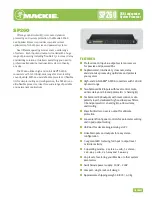
Additional Resources
Feature Pack Deployment Guide
72
Installing the Feature Pack
For detailed instructions for installing the Feature Pack on the Windows Storage server
computer and the Exchange server, see the
Microsoft Windows Storage Server 2003 Feature
Pack Installation Guide
, located in %ProgramFiles%\Windows Storage
Server\Exchange\Installation_Guide.doc
.
For information about Windows Installer arguments, see “Command Line Options” in the
Windows Installer documentation in the
Platform Software Development Kit (PSDK) at the
Microsoft Web site (
http://msdn.microsoft.com
).
Moving Exchange Files to a Windows Storage Server Computer
For information about using the Remote Storage Wizard or the WSSExchMove.exe command-
line tool to move Exchange databases and log files to a Windows Storage Server computer, see
Help for Remote Storage Tools for Exchange (%ProgramFiles%\Windows Storage
Server\Exchange\RemoteStorage.chm, on the Exchange server).
For information about using the Microsoft Web User Interface for Windows Server™
Administration (Web UI) to create Server Message Block (SMB) shares to host Exchange files
on a Windows Storage Server computer, see Help for the Web UI.
Administering Exchange Databases
For general information about using Exchange Server 2003 to perform database administration,
or to learn how to administer and manage Exchange server clusters, see the Microsoft
Exchange Server 2003 Administration Guide on the Microsoft TechNet site
(
http://go.microsoft.com/fwlink/?LinkId=21769
).
For information about creating storage groups in Exchange 2003, see Help for Exchange
System Manager.
For information about using Recovery Storage Groups in Exchange, see “Using Exchange
Server 2003 Recovery Storage Groups” (
http://go.microsoft.com/fwlink/?LinkId=23121
).
For more information about Exchange clusters, including cluster capacity and configuration
considerations, see the Microsoft Exchange Server 2003 Deployment Guide on the Exchange
2003 Deployment website (
http://go.microsoft.com/fwlink/?LinkId=23412
).
For general information about troubleshooting problems with Exchange databases, see
Microsoft Knowledge Base article 328763, “Troubleshooting a Corrupted Exchange Database”
(
http://go.microsoft.com/fwlink/?LinkId=23122
).
For information about running ESEUtil.exe on a Windows Storage Server computer or on any
server other than an Exchange server, see Microsoft Knowledge Base article 244525, “XADM:
How to Run Eseutil on a Computer Without Exchange Server”
(
http://go.microsoft.com/fwlink/?LinkId=23123
).
For information about defragmenting a database by using the ESEUtil.exe utility, see
Microsoft Knowledge Base article 192185, “XADM: How to Defragment with the Eseutil
Utility (Eseutil.exe)” (
http://go.microsoft.com/fwlink/?LinkId=23124
).
For information about checking the integrity of a database by using the ESEUtil.exe utility, see
Microsoft Knowledge Base article 825088: “How To: Use the Eseutil Utility to Detect File
Header Damage in Exchange 2003” (
http://go.microsoft.com/fwlink/?LinkId=23125
).
For information about repairing a database by using the ESEUtil.exe utility, see Microsoft
Knowledge Base article 327156: “Error Message: The Database Files in this Storage Are
Inconsistent” (
http://go.microsoft.com/fwlink/?LinkId=23126
).
Summary of Contents for PowerVault 770N
Page 6: ...Contents Feature Pack Deployment Guide 6 ...
Page 10: ...Introduction Feature Pack Deployment Guide 10 ...
Page 36: ...Installing the Feature Pack Feature Pack Deployment Guide 36 ...
Page 56: ...Applications and Exchange Tools Feature Pack Deployment Guide 56 ...
Page 62: ...Feature Pack Deployment Guide 62 ...
Page 70: ...Detailed Report Log File Feature Pack Deployment Guide 70 ...


































